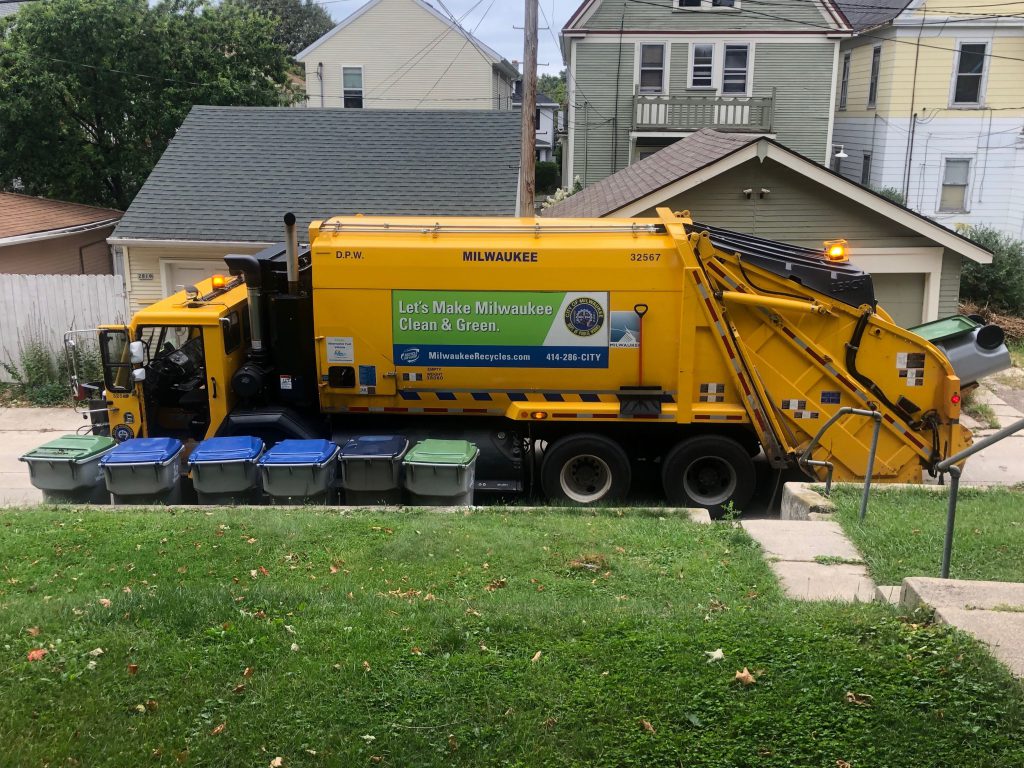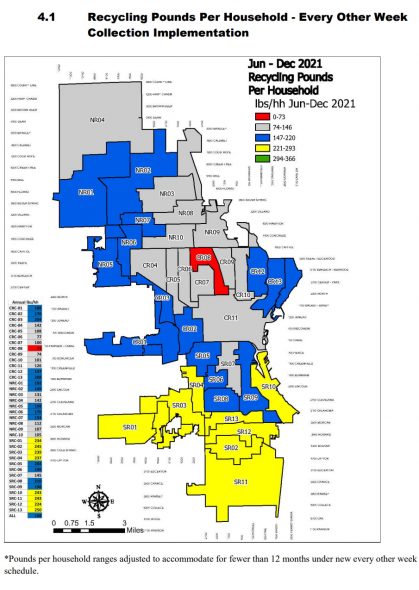City’s Recycling Up 9%, Revenues Up, Too
New methods of collection boost amount recycled, supply-chain issues increase revenues.
Milwaukee’s move to standardize its residential recycling pickup appears to be paying dividends, even as more people, post-pandemic, shift back to working in an office.
But the notable change is coming not from people seeing their recycling picked up more frequently, but from those who are actually getting it picked up less.
Now every residential property of one-to-four units in the city is under biweekly pickup using 95-gallon carts.
The households with the small, 18-gallon carts were in an area bounded by W. Capitol Dr., W. Canal St., N. 35th St. and the Milwaukee River. That area long had the lowest recycling materials collections by far in the city. From September to November 2020, it was 7.2 pounds per household per month. Over the same period in 2021, with the new carts, it jumped to 13.6 pounds per household per month, an 89% increase even as recycling trucks came around half as often.
Households that were on the every-third-week pickup cycle were creating an average of 22.5 pounds per household per month of recyclables. That went up by 0.2 pounds after the frequency was increased to every two weeks.
A 2020 report estimated that it would cost the city $125,000 annually to standardize the pickups and that the city would pick up 5,000 more tons each year. To reach that point, recycling would need to increase by another 10% versus 2019. It appears the city nearly hit that increase.
DPW collected 26,016 tons of recycling materials in 2021. That is down (barely) from the safer-at-home 2020, by just 91 tons (0.3%), but up significantly from 2019, when the city picked up 24,344 tons.
According to an annual program report, the recycling program avoided $1.2 million in landfill disposal costs and earned $2.1 million from the sale of materials. That’s up from $1.3 million in 2018, during a period when China stopped buying many recycling materials and caused the market to bottom out. DPW attributes the surge in prices to an increase in material demand as a result of the COVID-19 supply chain issues.
“We’ve seen almost all materials go up in value,” said then-DPW resource recovery program manager Samantha Longshore in presenting the report to the Public Works Committee on May 18.
What exactly are Milwaukeeans recycling? A lot of paper and glass bottles.
The average Milwaukee home recycled 278 pounds of material in 2021.
One counterintuitive factor about the city’s recycling effort is that by weight, electronics recycling continues to fall. It peaked at more than 1,400 tons in 2016 and fell to approximately 700 tons last year. What’s causing that? The disappearing tube TV. Milwaukeeans are taking fewer and fewer cathode ray tube (CRT) televisions to the two drop-off centers. The drop in electronics tonnage trend reflects other product changes as well, including today’s lighter phones, laptops versus desktop computers, etc.
DPW reported spending $11.27 million on the recycling program in 2021. That number falls to $5.62 million after accounting for state aid ($2.3 million), material sales and avoided landfill costs. Compared to throwing the same tonnage in the trash, the recycling program produced a net benefit of $1.73 million or $66.68 per ton
Despite the standardization of recycling pickups, Milwaukee’s economic disparities are apparent in the amount of recycling collected. The economic prosperity of an area positively correlates with the weight of recycling collected. But it’s an imperfect measurement, in part because under state law the city picks up garbage, but not recycling, from buildings with five or more units.
In 2021, the greatest per household pickups occurred on a southside route roughly bounded by Oklahoma Ave., Morgan Ave., S. Pine St. and S. 27th St. (250 pounds per household after June 1).
The lowest six-month pickup total, 73 pounds per household, occurs on an L-shaped northside route west of N. Teutonia Ave. between W. Capitol Dr. and W. North Ave. Much of the route, which stretches towards N. Sherman Blvd., is part of the former 18-gallon, weekly pickup route. A route immediately east of N. Teutonia Ave. collected only 74 pounds per household. But both figures are 100% increases over 2018, when the area yielded 75 pounds per household over the entire year.
Want to help the city recycle? Put your recycling directly into the bin without a plastic bag around it. The bag isn’t recyclable through the city’s process and jams its machines.
If you think stories like this are important, become a member of Urban Milwaukee and help support real, independent journalism. Plus you get some cool added benefits.























